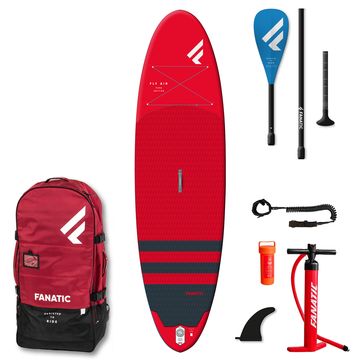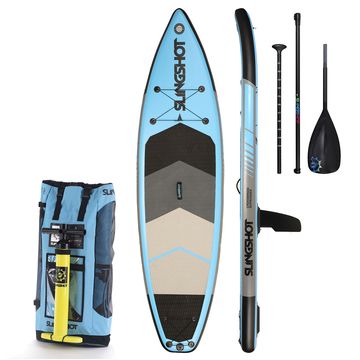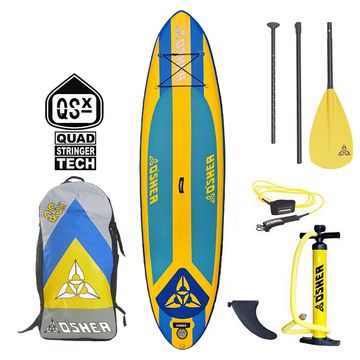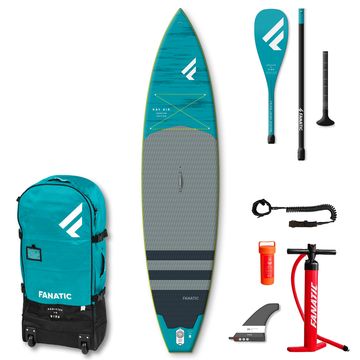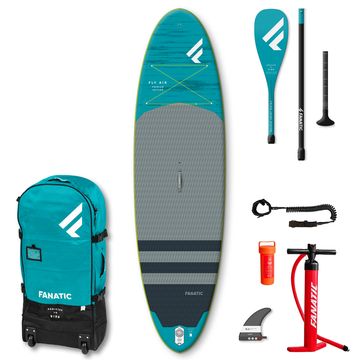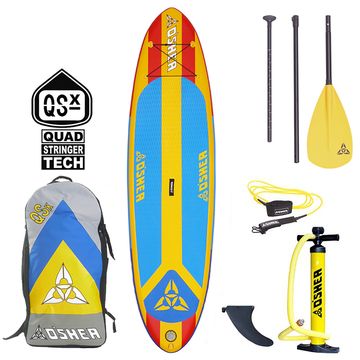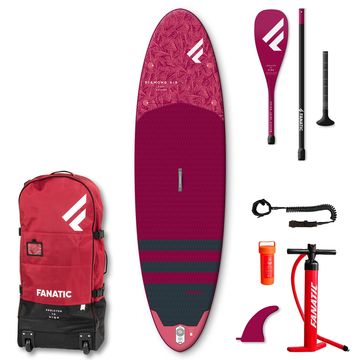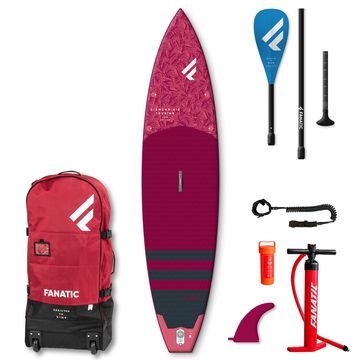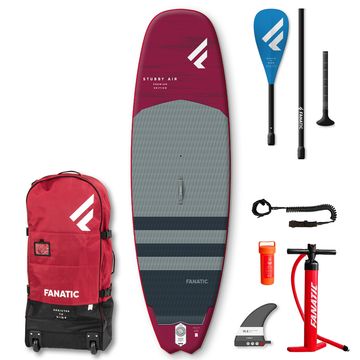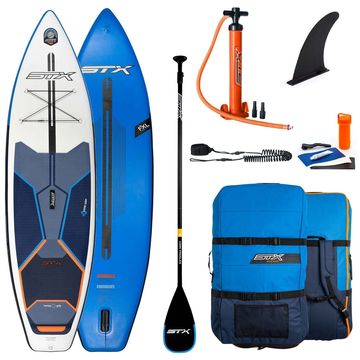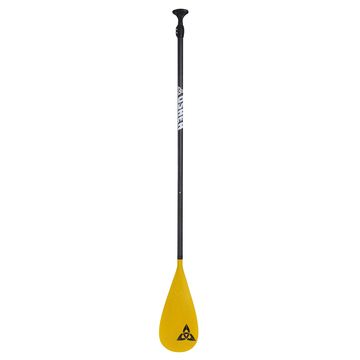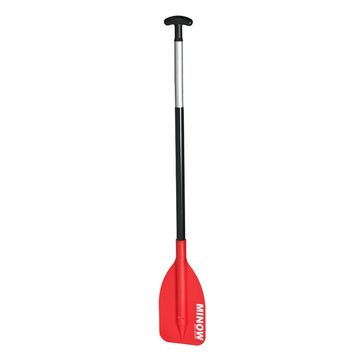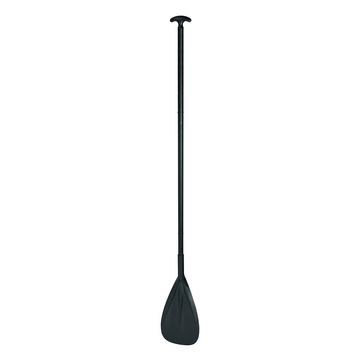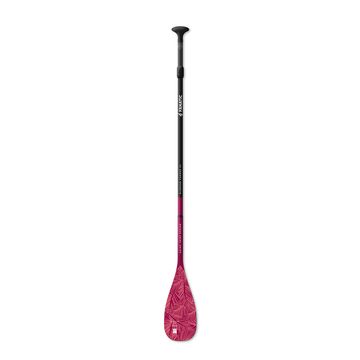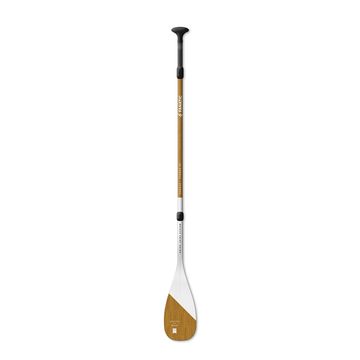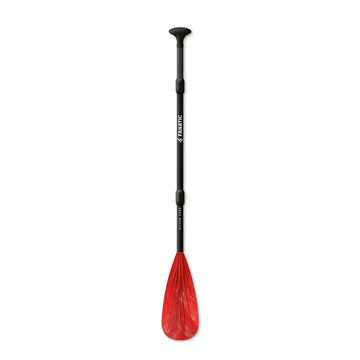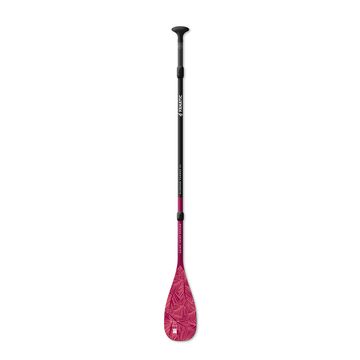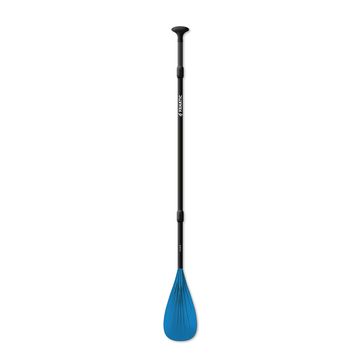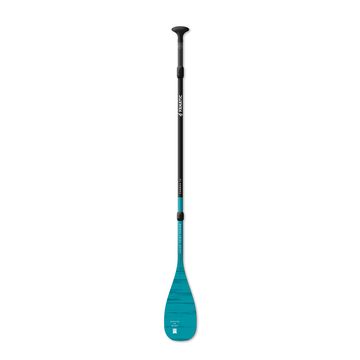Paddleboarding Buyers Guide
Paddle boarding has been growing for the past decade and is now one of the most popular water-based sports in the world. Paddle boarding can be traced back to the 1940s in the Hawaiian Islands as surf instructors stood on their surfboards to enable them to see their students easier.
Content created by King of Watersports KOW Copyright
Nowadays SUP’s are being used as a tool to access the water by lots of different people in many different ways. It’s become a way of exploring coastlines, single and multi-day tours, surfing, hydro foiling, family fun at the beach as well as racing in the sea, lakes rivers and canals. With all these activities available in one sport, boards have developed to become lighter, stronger more durable and most importantly - user friendly.
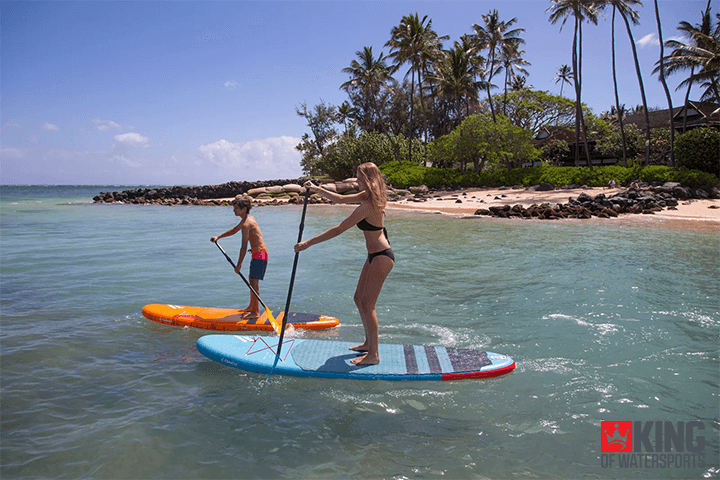
PADDLEBOARD CONSTRUCTION
Solid & Inflatable
Solid boards are the more expensive and performance orientated end of the SUP world. Their shape will vary depending on the discipline being undertaken but the fact they are solid means they can be shaped to give the most streamlined shapes and effective rails.
Inflatable boards have become the big seller of the last few years. The fact they are inflatable means the board can be easily stored and transported (easily in the car or in their bag) to the nearest stretch of water without the need for roof racks or a big garage. The inflatable boards gain their rigidity as they are inflated. As the air fills the chambers and the board expands, the top and bottom of the board pulling against each other via thousands of individual strands (known as drop stitching) woven into the inside. This complex weave gives the board strength and stiffness as well as keep them really light. With the boards being strong, easily storable, and cheaper over the last few years there have been more and more people able to enjoy being a paddleboarder.
Brands will have different constructions of inflatables that will suit different budgets. The more expensive versions being double lined – this will make a board more rigid and stronger (not indestructible) which will mean more of your energy from each paddle stroke will translate into forward movement and not flex of the board. As the board will have two layers it will be heavier than the cheaper single lined boards. These boards will be lighter as there is not as much material in the board, but they may flex a little more so it’s much more important to pump it up to the manufacturers recommended pressure. As they are single lined, they will be a little more fragile and won’t take to being run up a beach or slipway too kindly.
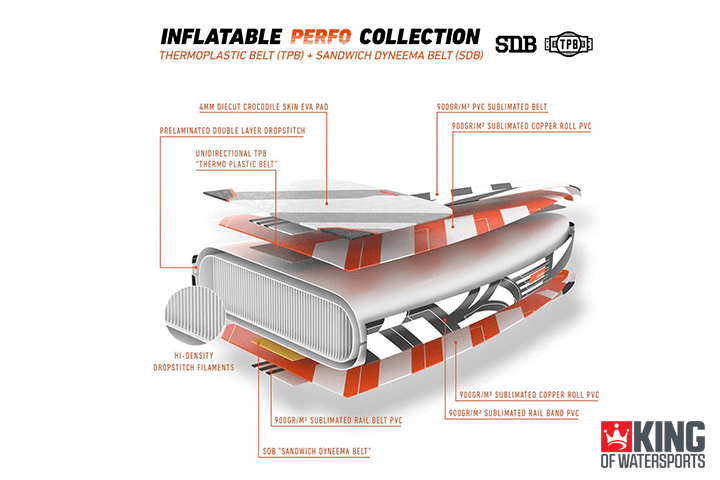
TYPES OF STAND-UP PADDLE BOARDS.
Depending on what you want to do there are shapes of board that will be more suitable and choosing the right board will make life more enjoyable.
The main SUP categories are:
All Round – Touring – Race – Surf
All-round boards are typically thick and wide which provides stability and suitable for most people. These are great for all levels of paddleboarder as they are stable and user friendly. They tend to be between 32” – 35” wide and 4”-6” thick. The nose and tail of the board will usually be quite wide as this also helps with stability. Everything about them is designed to get you on the water and enjoying being afloat. Some models will have an option to add a windsurf rig so you can enjoy your Sup powered by the wind.
Touring boards are optimised for flatwater, open ocean paddling, and ‘downwinders’ (going from point A to B with the wind at your back). They are typically longer than all-round boards, and often have a nose that is pointed to help the board slice through the water smoothly, increase glide and help the board go straight. Most touring boards are wide enough to be stable for beginners. Board sizes vary from 11’ – 14’ in length and 28” – 34” wide. The longer and narrower a board is the more efficient it will be slicing through the water but at the sacrifice of stability.
Race boards are designed for speed with comfort and stability being pushed aside for performance. They are similar in shape to a touring board in the fact they are long with pointed noses but where they differ is their width - typically narrower 27”-28” wide. Race boards tend to either be 12’6 or 14’ long as these are race standards.
Surf specific stand-up paddle boards are typically shorter, have a narrower nose and tail and more rocker (curve). Surf paddle boards are perfect if you are always going to spend your time in the surf. The narrow shape makes the board much more manoeuvrable on a wave, but the trade-off is that is that they are slower and don’t track in a straight line on flatwater and are also often less stable.
Crossover boards have been designed to try and make a single board as multipurpose as possible. Of then they are all round boards with a few extra features that make them usable in other situations. Some all-round boards will taper in towards the nose to give a pointier more streamlined shape that will work better for going longer distances. Likewise, some of the smaller all-round boards will work for surfing.
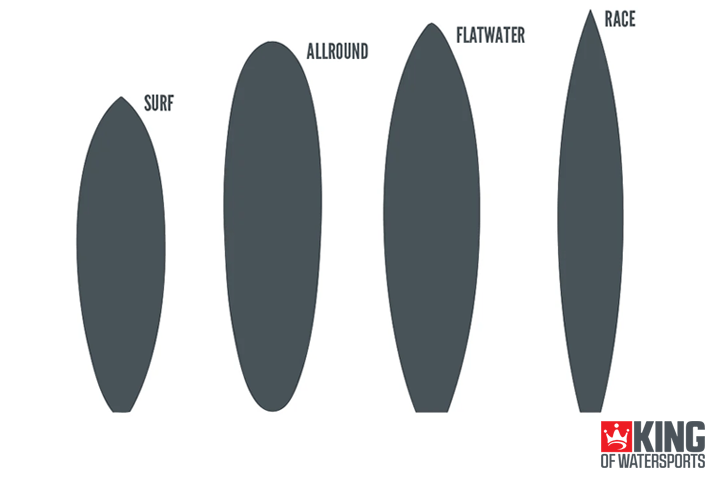
PROS AND CONS OF SOLID OR INFLATABLE SUP
Solid stand-up paddle boards are always going to be more efficient through the water as they will not flex at all. They also will have more shape to them – meaning the rails will sharper and harder giving a better release of water and less drag. These more defined rails will be more evident on the surf and race boards and will make the board faster, nimbler and will give you more feeling in what the board is doing. Depending on their construction they may be heavier than their inflatable counter parts but the more you pay the lighter it will be.
Inflatable stand up paddle boards are hard for manufacturers to get much shape into as the PVC they are made from is flexible until under pressure. This means they will never compete with a solid surf or race board in terms of performance even though they may be lighter.
WHAT SIZE BOARD DO I NEED?
There are many ways of trying to work out what size board you should use but there is no exact science when choosing (even if you find a SUP Size Calculator somewhere online). It will vary on your ability to balance as well as the conditions you take it out in. Someone who has not done any paddle boarding before is going to feel a bit wobbly on any board you put them on to start out - the more time they spend on it the stable they will feel. Having lessons or joining a SUP group will help iron out any flaws in your technique which should make balance less of an issue.
1 litre of volume will float 1kg of weight.
With that in mind a board with a volume of twice your weight in kg will be pretty stable. Many of the All-round boards will have between 250L and 300L meaning they will be super stable for most weights.
Width also contributes massively to stability with most all round and touring boards being between 30” – 35”.
Some of the best SUP Surfers in the world will use a board with less volume than their weight as the board will be small, nimble, and lightweight.
WHAT PADDLE DO I NEED?
A paddle for stand-up paddle boarding consists of three parts:
- Handle
- Shaft
- Blade
Handle
SUP paddle handles either have an ergonomically design to fit the palm of your hand or a straighter ‘T bar' feel. The ergonomic handle design is more popular, but some people do prefer the traditional 'T bar' grip.
Shaft
The shaft is considered the most important part of the paddle, it can be made of Aluminium, Glass fibre, Carbon, and sometimes Kevlar.
The material of a paddle makes a big difference to the performance.
- Aluminium - Rigid material, which can be heavy. These are usually the most basic paddle options but will do the job.
- Glass fibre – A slight upgrade over aluminium, they will be lighter and have a bit more flex which make a paddle softer through the water
- Carbon - Most performance material. Lightweight and strong and will give the best power transfer meaning more distance per stroke.
- Kevlar - High impact resistance, which performs very similar to Carbon. Often integrated into carbon paddles.
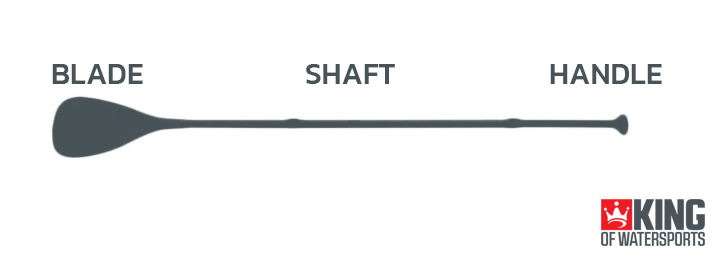
Blade
Stand up paddle blade sizes can vary from large too small. A large blade will displace more water in the paddle stroke and offer more power on demand. However, in the hands of a beginner paddler, the larger blade size may disable them with shoulder pain over time.
As a rule of thumb, smaller blades are generally preferred in the surf and are gentler for all users. They are usually more suitable for ladies, and juniors for all round paddling. Larger blades are used more in distance or downwind paddling.
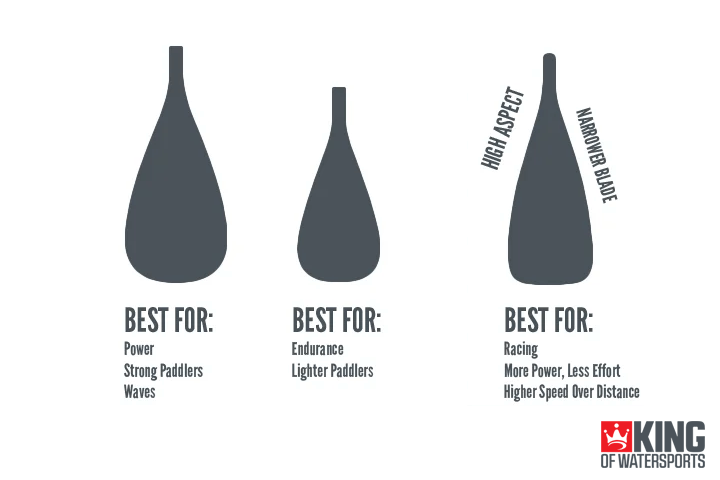
Height of Paddle
To maximise your performance and enjoyment on the water, you need to have the correct stand-up paddle length/height for the type of paddling you decide to do.
Surf SUP paddles are usually between 6-8 inches above the paddlers height due to lower stance taken in surfing.
Flatwater SUP paddles are usually between 8-10 inches above the paddler’s height for improved reach and power in each paddle stroke.
Racing SUP paddles are usually between 10-12 inches above the paddler’s height for maximum reach and power in each paddle stroke for speed.
If you want to stand up paddle board in both the surf and on the flatwater, you can either buy two paddles or buy an adjustable.
These are are great starting point for paddle height and are by no means are hard and fast rule. Most paddles are easily adjusted so if you feel you are reaching forward the paddle is too short. If you are reaching back or twisting your upper body to get the paddle to release from the water then the paddle is too long.
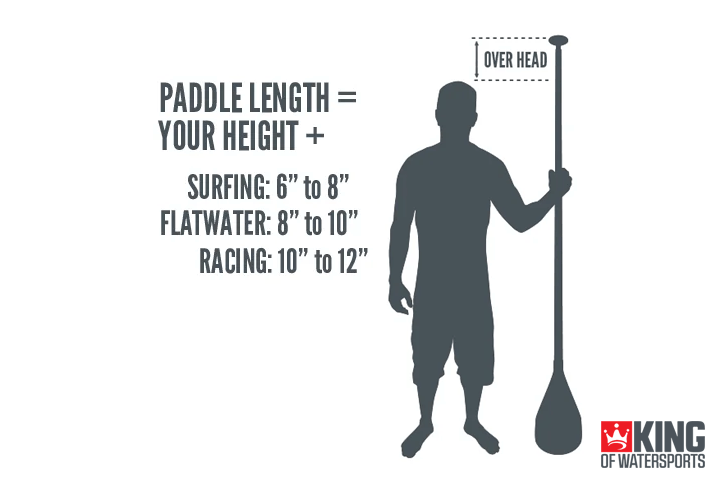
SUP Safety
If you’re going out paddle boarding, then there some essential things to ensure you check before you go.
- Weather – wind speed and direction
- Clothing and equipment suitable for conditions.
- Kit – Board fully inflated and not leaking. Leash attached
Wind can make or break any SUP session and is often overlooked. There are two considerations for wind when paddle boarding direction and strength. Light winds will make paddling in any direction easy but as the wind strength picks up it becomes harder to paddle into and across the wind meaning it can be harder to control your direction. Most people will paddle in places sheltered from the wind but if the wind is blowing from the land out to sea the water in close will be sheltered but as you get out further it will generally be stronger. With a strong offshore wind, it can make it tricky to get back to land.
The U.K. weather is variable and even in the height of the Summer the water temperature doesn’t get much higher than 16°C so getting suitable clothing for the conditions your paddling in is advisable especially if you’re going to be heading out in the colder months.
SUP Leashes
Most boards are supplied with a leash and this is something you should wear every time you go afloat. It ensures that you cannot be separated from your board. Being with the boards will make it easier to find you if the worst does happen.
There are two styles of leashes:
- Coil: This leash is designed to stretched out when under tension (ensures your board is at safe distance when you fall off) and to coil up compactly when paddling. This helps prevent the leash from dragging in the water.
- Standard: This is a regular cord leash like surfboard leashes. These are less likely to tangle if you are moving around on the board. They will drag in the water but are usually lighter than a coil leash.
Buoyancy Aids
When choosing a buoyancy aid its essential its essential fits correctly and is fit for purpose. You should be able to comfortably move whilst maintaining a snug fit.
Wetsuits
A good wetsuit can allow you to extend the paddle season well past the warm days of summer and even into the cold winter. You can add booties, gloves, and a hood to still get out even in the winter conditions.
For mor info on kit to wear head to
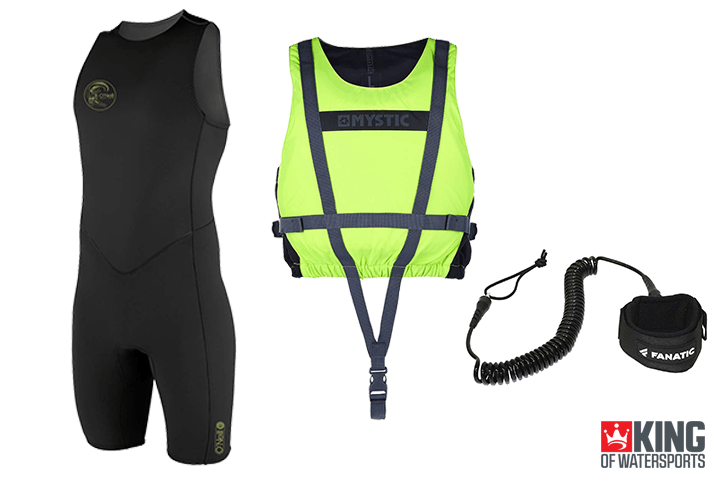
WINGING
The new sport of winging has blown into the world and could be a way to enjoy your SUP on those windier days. Adding a wing to your SUP could mean that your no longer at the mercy of the wind but you can harness the power to propel you along.
WHAT BRAND SUP DO I WANT?
At King of Watersports, we only stock the highest quality stand up paddle board brands in the industry. Whichever brand you choose with us, we guaranteed you will be very happy and hitting the water.
You can choose a brand that you know or try out a new one - we are confident that all our SUP brands have great like for like features of the highest standard.
HOW DO I LOOK AFTER MY NEW SUP EQUIPMENT?
Once you have bought your new stand-up paddle board equipment, the guidelines below will help you maintain and extend the life of your gear.
- Store your SUP equipment out of the sun, in a dry and shaded area.
- Transport your SUP board and paddle in a protective bag to prevent damage.
- Be careful putting the board in the water and taking it out. There may be rocks or other sharp objects when putting your board down.
- Be careful when you are paddling and avoid any obstructions that can damage your board, paddle, or fin.
- Wash your SUP equipment after going in saltwater, be sure to get the fin boxes, slider nut and screw, as well as the deck pad.
- Regularly check for crease marks on inflatables and any dings and cracks on your board and paddle – these will only get worse over time.
Content created by King of Watersports KOW Copyright

